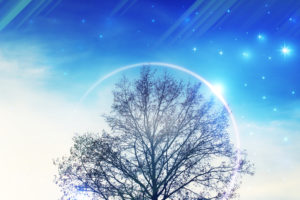
Throughout history, human civilizations have developed a wide range of beliefs to theorize the universe’s structure and workings. A few examples include the “dome of heaven” concept, found in the book of Genesis and in stories throughout the ancient Middle East, as well as legends of a giant turtle carrying the world on its back from Hindu, Chinese, and several American Indigenous cultures. The Nine Worlds, an ancient Norse cosmological system, also looks to nature to explain the physical world and supernatural realms.
A Giant Tree Connecting All of Existence
Several pre-Christian Germanic cultures believed that the physical world consisted of nine separate realms, all interconnected by an immense “World Tree” at their center. This tree, known as Yggdrasil, appears in several old Norse myths. You may have heard of it as a giant arbor on which the all-father deity Odin hung himself for nine days and nights to learn the secret of the runes. The New World Encyclopedia clarifies that its name could translate as “terrible steed” or “terrible gallows,” the latter hinting at Odin’s famous sacrifice. However, portions of the Poetic Edda also call it “Mimameid” after Mimir, a primal god of knowledge whose well found a home inside the tree’s root network.
The Nine Worlds Around Yggdrasil
Historian Daniel McCoy points out that there is no single source listing all nine realms. Nevertheless, references to the realms from which various beings hail can be found throughout both the Poetic Edda and the Prose Edda. McCoy provides a list of these realms, based on reconstructions from Norse source texts:
- Asgard, home to the Aesir tribe of deities
- Vanaheim, the realm of the Vanir clan of deities
- Midgard, the physical world in which humanity dwells
- Jotunheim, land of the Jötnar clan of deities
- Alfheim, the realm of the elven people
- Svartalfheim, home of the dwarves
- Muspelheim, a primordial world of fire
- Niflheim, a primeval realm of ice
- Hel, an eponymous underworld ruled by the goddess of the dead
While there isn’t a source that names the distinct placement of these realms around Yggdrasil, modern artistic renderings based on available sources usually place Asgard in its branches, Midgard in the center, and Hel under its roots, depicting all other worlds structured somewhere up the tree’s trunk and branches. However, a verse of the poem “Grímnismál” in the Poetic Edda insists that Yggdrasil has three roots: one above Hel, a second above Jotunheim, and the third above Midgard.
The Concepts of Innangard and Utangard
Judging from the writings they left behind, pre-Christian Germanic peoples viewed these realms through the lens of order striving against and balancing with chaos. It’s notable that both Midgard and Asgard contain the Norse root “-gard,” signifying an enclosed space. Hence, both regions were considered “innangard,” or “within an enclosure,” whereas regions such as Vanaheim, Jotunheim, and Alfheim were probably classified as “utangard,” or “outside the enclosure.” Thus, humans and many of the gods lived in civilized structured spaces, while the Jötnar, some of the Vanir tribe deities, elves, dwarves, and other mythological creatures occupied more chaotic realms. As McCoy explains when describing the “innangard” and “utangard” concepts, neither are viewed as inherently good or bad. Wild “utangard” power and energies can be put to constructive use, but these may become destructive when untampered.
A Natural Order That Relies on Balance
Norse mythology reveals a worldview rationalizing the coexistence of both order and chaos in a grand supernatural structure. While the Nine Worlds and the World Tree connecting them exhibit a logical structure, many realms and their inhabitants display unpredictable natures. Unlike the Christian moral dichotomy of good versus evil, pre-Christian Germanic cultures saw the universe as a balance between ordered civility and untamed chaotic elements.

